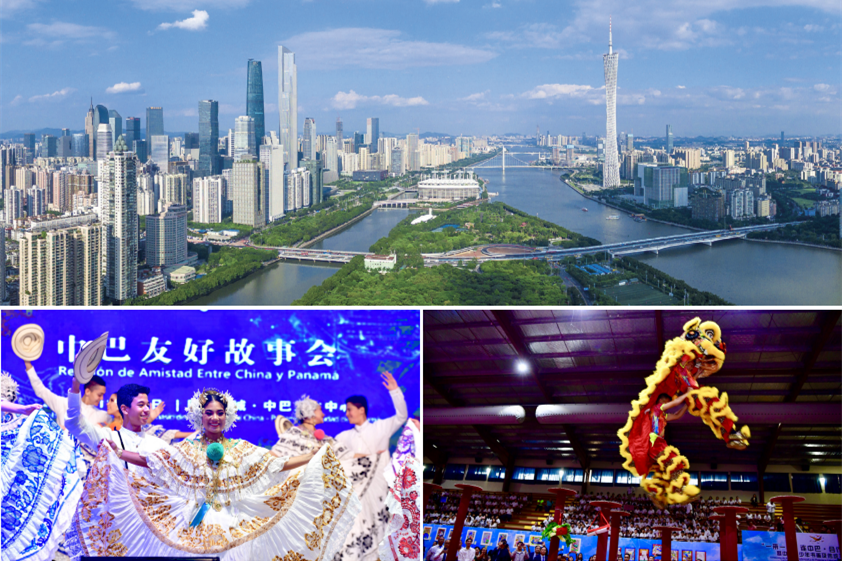
The southern Chinese city of Guangzhou, top, continues to be at the forefront of deepening relations between China and the Latin American and Caribbean countries. Above left and right, the recent story-sharing session in Panama City that celebrated growing Sino-Panamanian friendship.
In 1854, some Chinese people got on board a ship called Sea Witch, and left the province of Guangdong in southern China for Panama. This group, seen as the first Chinese settlers, were about to build a sea-crossing railway over the Panama Canal. That was the beginning of more than 160 years of exchanges between China and Panama.
There is no denying that Guangzhou, the cradle of China’s Maritime Silk Road and an evolving business and trade centre, has been a pioneer in Sino-Panamanian ties that have continued to develop.
China is now joining hands with Latin American and the Caribbean (LAC) countries and regions to build a platform for international co-operation along the Belt and Road, and Panama is a critical connector as the 21st-century Maritime Silk Road is extending to the LAC.
In the run-up to the G20 summit, being held in Argentina yesterday and today,a story-sharing session on the ChinaPanama friendship was held in Panama City. Focusing on the win-win co-operation and shared development brought by the Belt and Road Initiative that connects China with Panama, the session was joined by Panamanian government officials, leading overseas Chinese people and experts and scholars from both sides. They shared stories about exchanges in many areas, including mutual help and benefits involving Guangzhou. Participants agreed that the Chinese city is a participant and promoter of Panama’s development, contributing wisdom and strength from infrastructure construction and trade to education.
In the past year, Feng Yadi, president of the Chinese Association in Panama and the Colón Free Trade Area (FTA), has been devoting himself to creating an enabling environment for Chinese companies in Panama. As a frequent participant in the Canton Fair, a worldrenowned biannual comprehensive trade fair held in Guangzhou, Feng, travelling to the city every year, witnesses the increasing and deepening business exchanges between China and Panama as well as the LAC region.
As of now, China has established diplomatic relations with 24 LAC countries. Among them, Panama leads the way in the infrastructure industry and a testament to that is a high-speed railway from its east to west. Meanwhile, by establishing diplomatic relations with China, Panama will boost its logistics economy, according to Leonardo Enrique Collado Trejos, an economist and professor at the University of Panama in Azuero.
Alexandre Meira da Rosa, vice-president of the Inter-American Development Bank (IDB), said this demonstrates the tremendous potential and prospects for co-operation between the two sides. “China, with its world-class infrastructure, has inspired us to examine and resolve the imperative problems with foresight,” said da Rosa in front of hundreds of businessmen from China and the LAC at the 12th China-LAC business summit recently held in Guangdong.
It was expected that da Rosa’s call would be reiterated at the G20 summitalong with the meeting’s focuses on sustainable development and enhanced infrastructure construction. And China, fully committed to high-quality development, is undoubtedly the most welcome participant for the LAC countries.
For them, major infrastructure including bridges, ports and high-speed railways is an epitome of China’s reform and opening-up policy that has been promoted for four decades. During the period, the Pearl River Delta, represented by Guangzhou, has developed into a global manufacturing base, where high-tech industries developing communication equipment and mobile phones have grown, serving as a leading example of the forward-looking vision for the LAC and beyond. “The LAC region can benefit from how China pursues development. We look forward to having dialogues with such an innovative and entrepreneurial region. Simultaneously, deeper ties with the LAC will, in turn, deliver benefits to China. Through interconnectivity, we can join hands to seek new solutions for development,” said da Rosa.
Additionally, trade is what makes Sino-LAC relations more closely intertwined. In the past decade, trade volume between China and the LAC has developed more than 20-fold, with annual growth rates of 30 per cent and more. Thus China has become the second largest trading partner of the LAC. Most market observers believe that, with the Chinese middle-class consumer group expanding, the LAC has the opportunity to export more highly processed goods to China, which will be a game changer.
In the face of the global competition in emerging industries, the LAC is also showing growing interest in the investment from an innovation-driven China. The Bank of Investment and International Trade of Argentina focuses on developing renewable energy and new energy, new areas for Argentina in which local banks lack sufficient experience. “China, however, has rich experience. Co-operation with Chinese banks will reduce our investment risk,” said Pablo García, vice-president of the bank.
Never before has the institutional innovation of China been so integrated with that of the LAC. Built along the Panama Canal, the Colón Free Trade Zone, one of the most significant areas for Panama’s economic development, has enjoyed rapid growth in recent years. It is now expecting to join hands with the fast-growing Nansha area of Guangzhou, part of the China (Guangdong) Pilot Free Trade Zone, for shared development.
“Panama seeks to be a window for Chinese investment and products to enter the entire LAC region,” said Panamanian Minister of Industry and Commerce Augusto Arosemena.
The Maritime Silk Road connects China and the LAC, and the ties between Guangzhou and Panama are significant. Through this sea route, the two sides not only developed trade, but also promoted exchanges between two civilisations. Solid public opinion and emotional bonds help the two sides tap the potential to jointly build the Belt and Road.




